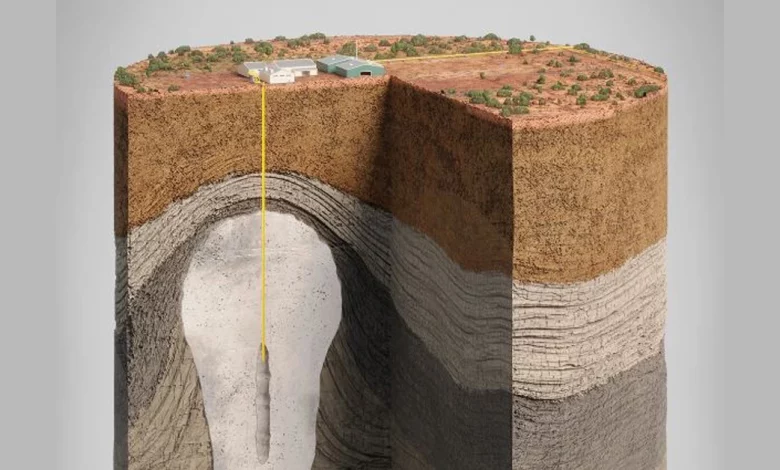
Context- In accordance with the government’s goal of expanding the country’s capacity for strategic oil storage, the engineering consulting firm Engineers India (EIL), which is owned by the government, is looking into the possibility of developing salt cavern-based strategic oil reserves in Rajasthan.
What are salt caverns?
- Salt caverns are fake cavities in underground salt developments, which are made by the controlled disintegration of rock salt by infusion of water during the arrangement mining process.
What differentiates it from rock caverns?
- Salt caverns are made by pumping water into geological formations that have large salt deposits to dissolve the salt, in contrast to underground rock caverns, which are made through excavation.
- After the saline solution (water with disintegrated salt) is siphoned out of the development, the space can be utilized to store raw petroleum.
- Additionally, unlike rock caverns, salt cavern-based storage can almost entirely be built and operated from the surface.
Benefits of a Salt Cavern
- The process is simpler, quicker, and less expensive than creating rock caverns from scratch.
- Salt cave based oil storerooms are additionally normally very much fixed, and designed for fast infusion and extraction of oil.
- Because of this, they are a more appealing choice than oil storage in other geological formations.
- These caverns are ideal for storage because the salt that lines them has a very low oil absorbency, making them naturally impermeable to liquid and gaseous hydrocarbons.
- Natural gas and liquid fuels are also stored in salt caverns in various parts of the world.
- They are also thought to be suitable for storing hydrogen and compressed air.
Indian scenario
- Countries build strategic reserves of crude oil to prevent major supply disruptions in the global supply chain.
- India, the world’s third-biggest shopper of rough, relies upon imports for over 85% of its prerequisite — and vital oil holds (SPR) could assist with guaranteeing energy security and accessibility during worldwide stockpile shocks and different crises.
- India currently has a SPR capacity of 5.33 million tonnes, or approximately 39 million barrels, that is sufficient to meet demand for approximately 9.5 days.
- At two locations, Chandikhol in Odisha (4 million tonnes) and Padur (2.5 million tonnes), the nation is currently expanding its SPR capacity by a total of 6.5 million tonnes.
- The special purpose vehicle known as the Indian Strategic Petroleum Reserve (ISPRL) is responsible for managing India’s strategic oil reserves.
- EIL played a crucial role in establishing the country’s SPR as the project management consultant.
- India is an “Association” country of the International Energy Agency (IEA), which says that every nation should have enough emergency oil to protect imports for 90 days.
- In India, the oil marketing companies (OMCs) have storage facilities for crude oil and petroleum products for 64.5 days in addition to the SPR, which are sufficient to meet the country’s oil requirement for 9.5 days. This indicates that there is sufficient storage to meet approximately 74 days of the country’s petroleum demand.
Potential and Related Changes
- Rajasthan, which is home to the majority of India’s necessary salt formations, is thought to be the best place to build salt cavern-based strategic storage facilities.
- Following in the footsteps of the reserves that the United States and its Western allies established following the first oil crisis in the 1970s, India’s strategic oil reserves are a component of the effort to construct sufficient emergency stockpiles.
- During the first phase of the program, the three rock cavern-based facilities that are currently in use were constructed.
- The Abu Dhabi National Oil Company (ADNOC) has stored approximately 0.8 million tonnes of crude oil in the Mangaluru strategic reserve, which India has also decided to sell.
- The government used the low crude oil prices in April and May 2020 to completely fill these reserves, resulting in savings of approximately Rs 5,000 crore.
- As part of a coordinated US-led action by major oil-consuming nations against the joint decision of major oil-producing nations to reduce output, India released 5 million barrels from its strategic reserves in 2021.
Issues
- None of the Indian businesses, including EIL, possessed the necessary technical expertise to construct salt cavern-based strategic hydrocarbon storage.
- According to Shukla, EIL’s most recent partnership with DEEP.KBB GmbH, a German company that specializes in cavern storage and solution mining technology, has closed this technology access gap.
- However, it is still too early to pinpoint a particular location or estimate the project’s cost.
Prospects for the Future
- Salt cavern-based storage, which is thought to be less expensive than rock caverns and requires less labor and money, could add a new, much-needed chapter to India’s SPR story.
- India may acquire its first salt cavern-based oil storage facility if the concept is realized.
- Excavated rock caverns make up the country’s three strategic oil storage facilities, which are located in Mangalore and Padur in Karnataka and Visakhapatnam in Andhra Pradesh.





.png)



